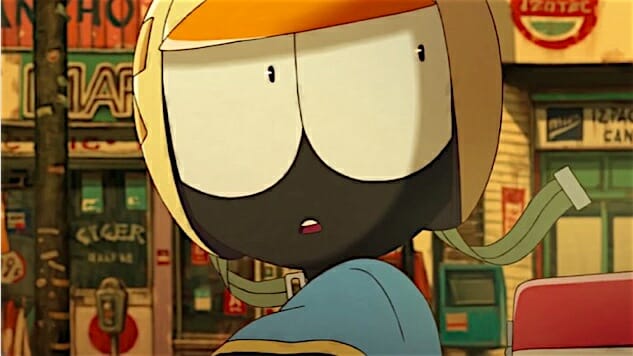MFKZ

France and Japan have always had something of a cross-continental love affair when it comes to art. From the impact of ukiyo-e prints on the rise of impressionism to the influence of Jean “Moebius” Giraud’s bandes dessinée comics on artists like Hayao Miyazaki and Katsuhiro Otomo, the aesthetic trajectories of these two countries have been in constant conversation with one another throughout history. MFKZ is only the latest link in this chain of cultural exchange, an international work whose origins stress the fault lines what can be known as “anime” or “world animation.”
Co-directed by Studio 4°C’s Shojiro Nishimi and comic author Guillaume “Run” Renard, MFKZ is adapted from Renard’s original comic Mutafukaz and follows Angelino, a onyx-skinned young man eking out a life of minimum wage survival in Dark Meat City, a funhouse mirror depiction of South Central Los Angeles by way of Brazilian Favelas. Angelino’s meek and unassuming life is upended when he crosses paths with a mysterious young woman and subsequently gets into an moped accident. Waking up with a splitting headache and suddenly ensnared in a centuries-old conspiracy by shadowy government agents, Angelino and his friends Vinz and Willy must find a way to escape the city alive, all the while uncovering the secrets of Angelino’s own forgotten past.
The concept of MFKZ has existed in some form or another for over two decades now, with the comic and an accompanying short film titled, Operation Blackhead in 2003 and animated by Renard himself. In interviews followingMFKZ’s initial festival circuit, Renard has cited the comic and movie as being a mash-up of “John Carpenter’s They Live meets Boyz n the Hood.” Given how prolific those influences in their respective orbits of pop culture, no one would accuse MFKZ of being modest in paying homage to them.
In a lot of ways MFKZ feels like a spiritual bookend of sorts to Tekkonkinkreet, another Studio 4°C production. Released in 2006, Tekkonkinkreet was notable for being the first Japanese animated film to be helmed by a non-Japanese director, Michael Arias. Aside from Nishimi and Shinji Kimura, art director on Tekkonkinkreet, returning to collaborate again on MFKZ, comparing these films and their respective settings and scenarios reveals some interesting parallels.
Tekkonkinkrett’s Treasure Town is a city of the past being engulfed by the new—a pan-asian industrial sprawl being gutted by opportunistic “foreigners” at the expense of disenfranchised locals. In the case of MFKZ, the stakes are global, but the film’s story is localized to South Central L.A., where wealth disparity and pollution are exacerbated through neglect and deliberate malice. Each city is host to a diasporic community of gangsters, roughnecks, wide-eyed children and the occasional anthropomorphic oddity trying to make this thing called “life” work, day by day.